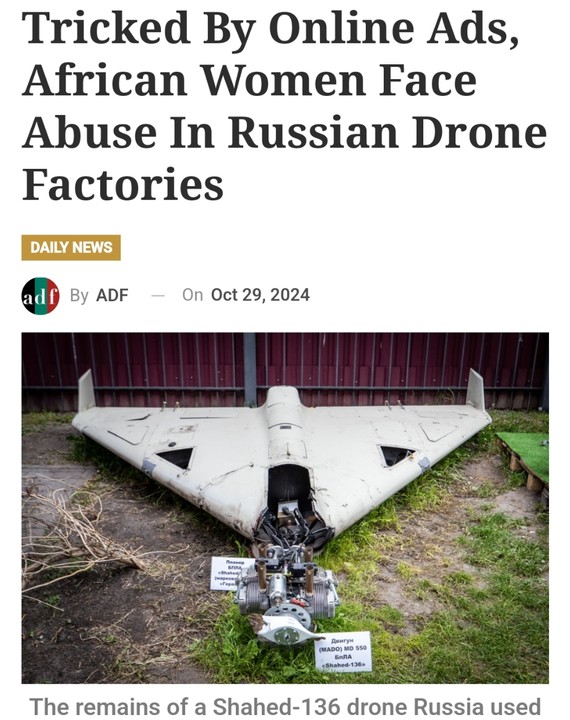
The young woman was enticed by social media ads promising a job, good pay and a new life in Russia. The advertising photos showed women smiling as they cleaned floors and wearing hard hats while directing cranes at a factory in the Republic of Tatarstan, Russia.
The ads included videos with upbeat music that showed African women visiting Tatarstan’s cultural sites or playing sports. They promoted a program called “Alabuga Start” that touted a free plane ticket to Europe and a well-paying job upon arrival.
Excited by the benefits of a work-study program in a field such as catering or hospitality, the young woman completed a computer game and a 100-word Russian vocabulary test featuring words such as “factory,” “to hook” and “to unhook.” She was accepted into the program and optimistic about starting a new chapter in her life — until she arrived in Alabuga, about 1,000 kilometers east of Moscow.
She soon discovered that her job was to help manufacture Iranian-designed attack drones for use in Russia’s war with Ukraine. She is one of about 200 African women, most between 18 and 22, recruited to work at the Alabuga factory. The women are from Kenya, Nigeria, Rwanda, Sierra Leone, South Sudan and Uganda.
They work to produce some of Moscow’s key war weapons with Russian vocational students as young as 16.
“The company is all about making drones. Nothing else,” the woman, who assembles airframes, told The Associated Press, which did not disclose where she was from to protect her identity. “I regret and I curse the day I started making all those things.”
Russia has begun efforts to lure young African women into factory work due to a severe manpower shortage. Russian officials held recruiting events in Uganda and tried to recruit from its orphanages. Most of the women recruited through the Alabuga Start program help manufacture drones, particularly the parts “that don’t require much skill,” David Albright, a former United Nations weapons inspector who works at the Institute for Science and International Security, told the AP.
It is not clear how much training the women receive, but one woman told the news agency: “I don’t really know how to make drones.”
Russia plans to produce 6,000 of the exploding Shahed-136 drones a year by 2025, according to the Institute for Science and International Security.
[The schedule is hectic for workers, who say they are “guarded around the clock” in their dorms and at work, sometimes work 12-hour days with sporadic days off, and that the pay is less than expected. The program initially promised the women $700 a month, but later social media posts put it at “over $500.”
The airframe assembly worker said that the costs of accommodation, airfare, medical care and Russian-language classes were deducted from her salary
Following the investigation, the social media sites connected to the Russian plant were removed from Google, Meta, TikTok, YouTube and elsewhere for violating policies and guidelines. But for the women already working in the factory, life is brutal. One woman told the AP that her “messages are monitored;” another said workers are told not to talk to outsiders about their work; while another said managers encouraged them to inform on coworkers.
The women are “maltreated like donkeys, being enslaved,” said the airframe worker.
She said that workers coat the drones with a caustic substance, but many workers lack protective gear. She said the chemicals made her face feel like it was being stabbed by tiny needles and “small holes” appeared on her cheeks, making them itch badly.
“My God, I could scratch myself! I could never get tired of scratching myself,” she told the AP. “A lot of girls are suffering.”
Human Rights Watch accuses Russia of recruiting foreigners to support its war in Ukraine by promising high-paying jobs without fully explaining the nature of the work. These actions “could potentially fulfill the criteria of trafficking if the recruitment is fraudulent and the purpose is exploitation,” Ravina Shamdasani, a spokesperson for the U.N. High Commissioner for Human Rights, told the AP.
The women also face the dangers of living and working in a war zone. In April, Ukrainian drones hit the Alabuga factory and one of Russia’s largest oil refineries in what appeared to be Kyiv’s deepest strike inside Russian territory since the war began. No one was killed, but 12 people were injured in the dual strikes. It was not clear if any of the injured were factory workers.
The factory’s production pace is ahead of schedule, but experts question the quality of the drones and whether manufacturing issues due to the unskilled labor force are causing malfunctions.
An AP analysis of about 2,000 Shahed attacks documented by Ukraine’s military since July 29 shows that about 95% of the drones hit no discernible target. They mostly fell into Ukraine’s rivers and fields, or landed in Belarus, Latvia and Russia.
In July, Russia launched 89 Shahed drones in a nighttime attack on Kyiv, Ukraine’s capital. They were all shot down.
“The air force is using electronic jamming against the drones’ GPS which forces the drones to fly at a higher altitude, which then makes it easier for Ukrainian aircraft to strike them down,” Anatolii Khrapchynskyi, an aviation expert in Kyiv, told the AP.
Now Playing: Love Bug
Aretti Adi
SPONSORED LINKS
LOAN FOR TRAVEL, VISA, JAPA, PoF UP TO N200M (CLICK HERE)
[CLICK HERE] For Music Artwork, Website Design And SEO Setup
INSTALL 9JAFLAVER MUSIC APP, STREAM, DOWNLOAD, AND PLAY MUSIC OFFLINE
CHECK OUT FUNNY PICTURE AND MEME HERE (CLICK HERE)
Chissom Anthony – Glory To God In The Highest [See Trending Gospel Song]
Copyright © 2014-2025 9jaflaver. All Rights Reserved.
About us | DMCA | Privacy Policy | Contact us
| Advertise| Request For Music | Terms Of Service
9jaflaver is not responsible for the content of external sites.